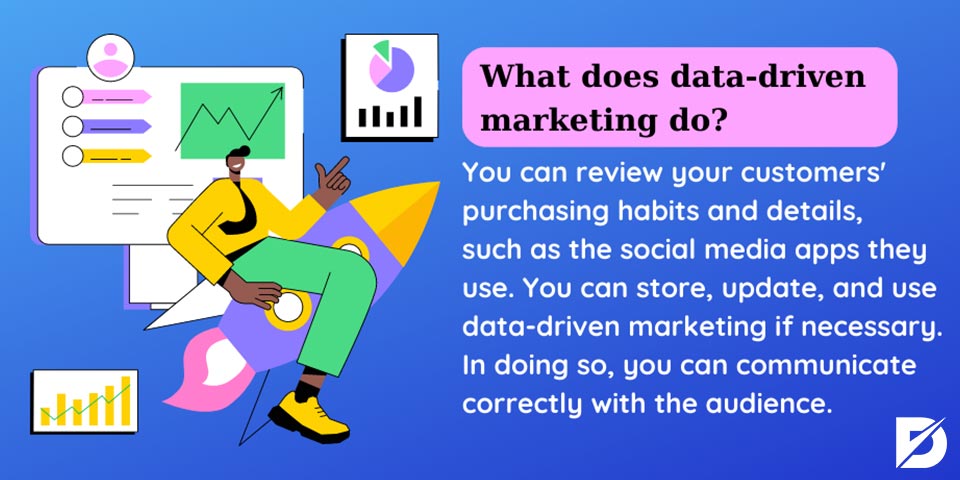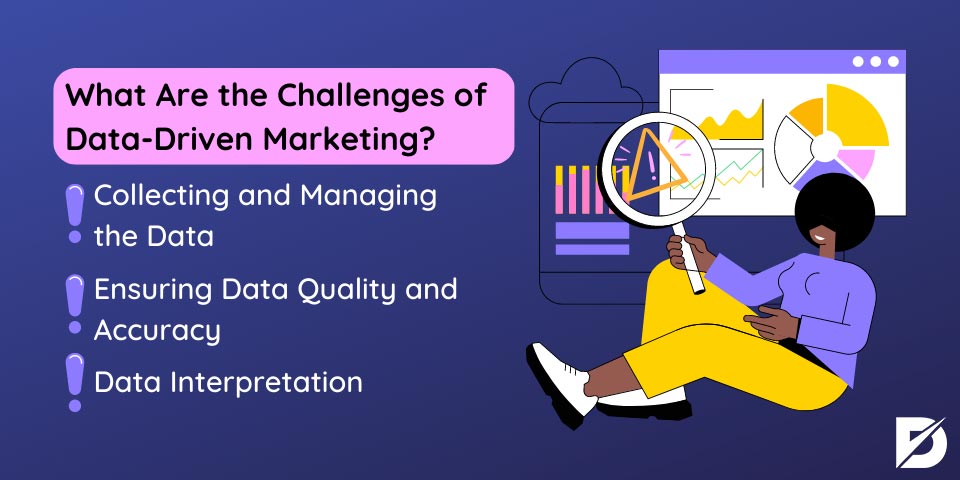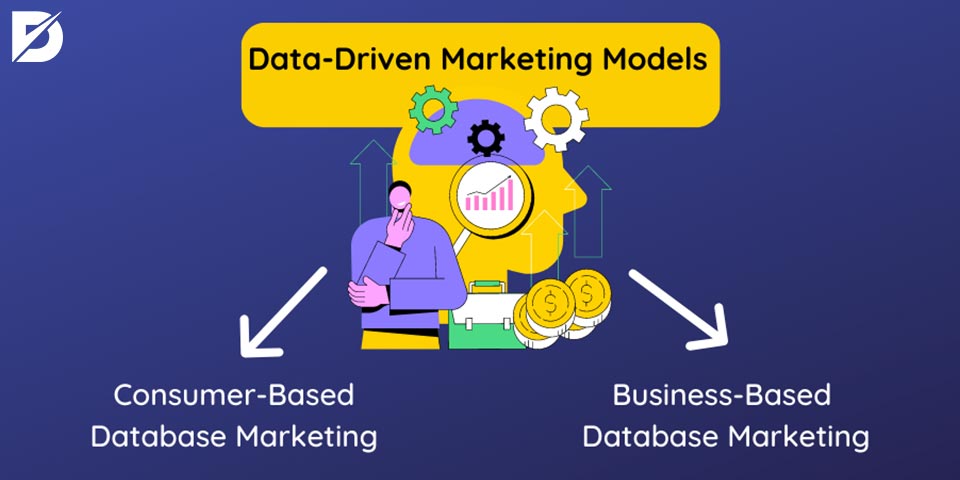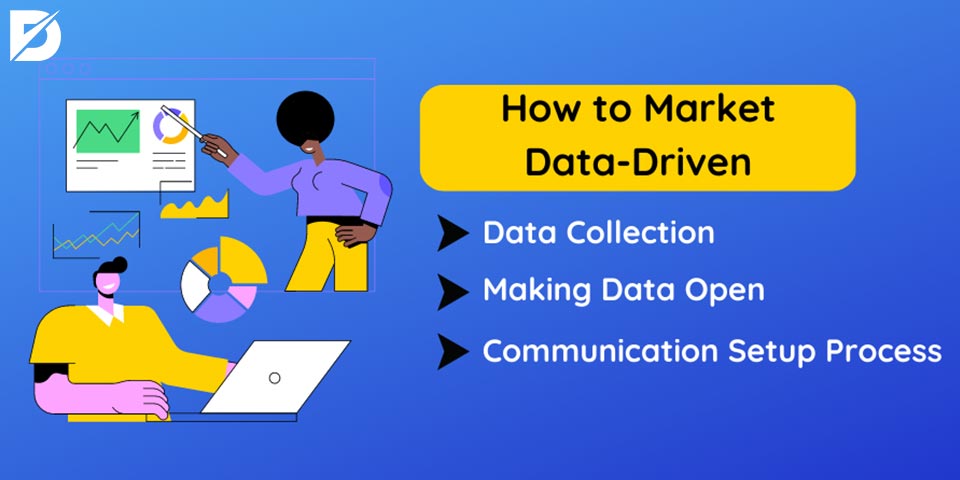Modern data-driven marketing began with the development of customer relations management (CRM) software. CRM tools enabled marketers to access people’s names and phone numbers in the first place. Over time, these tools reached their email addresses, paving the way for direct marketing campaigns from there. The real explosion of customer relationship management software was thanks to the innovation that brought them to the cloud system. As a result, the era of “data” in marketing began. This era paved the way for marketing automation software, and the two major leaders were Marketo and Eloqua. So, these two companies followed the user’s browsing web pages and pioneered the creation of a user-specific sales profile. Thus, the era of “marketing automation” began. So what is data-driven marketing? Let’s see.
Data-Driven Marketing
Data-driven marketing systematically collects and processes customer data in a company’s database. This is a process that helps companies develop existing and potential customers and meet their demands and needs. This way, companies conduct the marketing process using data about customer history.
In this section, you can review your customers’ purchasing habits and details, such as the social media apps they use. You can store, update, and use data-driven marketing if necessary. In doing so, you can communicate correctly with the audience.

As companies began digitizing, more customer information became available to companies. So now, you can optimize your work by using this data in the data-driven marketing process. You will use this marketing process to create a future marketing strategy with a customer-oriented focus. The first goal is to get detailed information about existing customers. You can use this data so that you can resell it later. As a result, it allows you to create brand loyalty and continuously repeat the customer-company relationship.
Companies have been using the data-driven marketing method for a very long time. However, with the digital marketing process recently developed worldwide, the data-driven marketing method has also begun to develop. By registering your business’s routine sales activities in the database, you can develop more effective strategies while marketing your products and services. Now let’s talk in detail about the purposes of data-driven marketing.
What Are the Objectives of Data-Driven Marketing?
We’ve said that many companies have been using data-driven marketing activities for a long time. As a result, companies aim to include digital policies in the data-based marketing process:
- Using customers’ data, create a marketing strategy that meets the target audience’s wishes.
- Create an effective project by profiling your customers when developing new products.
- Determine your customers’ responses to your products and services.
- Determine the customers that will bring a high profit to your company.
- By recognizing people who have shopped before you, you can determine which customer audience your products and services cater to.
- Thanks to the data you have, you can also turn to the right goals without unnecessary effort.
- Divide the big markets into new sections where you can work more comfortably.
- Decide to try different communication options along with different market slices.
- Use the distribution channels you have much more effectively.
- Start activities by identifying alternative distribution channels for your brand.
We explained what you could aim for in the data-driven marketing process. So let’s talk about the benefits your brand will get in the data-driven marketing process.
What Are the Advantages of Data-Driven Marketing?
Data-driven marketing can provide many benefits to your brand. Here’s what data-driven marketing will provide for your company:
- Increase your marketing efficiency.
- Expand your domain in the marketing process.
- Use the marketing budget you have taken in your company most effectively.
- Develop new strategies so people who have previously registered sales in your database can re-shop.
- Classify your customers according to their shopping habits and shopping frequency.
- Create special promotions, announce campaigns, and give gifts. You can deliver this work directly to your existing and potential customers first-hand.
- Carry out cross-selling activities.
- Identify customers who fit your profile by analyzing it through your existing customer potential.
- Re-earn by analyzing your customers who are no longer shopping from you
- Conduct a two-way communication process. You can identify customers’ reactions and develop new products based on the reactions you receive.
- Communicate by learning about customers who fit your profile; through the information, you can see data about the database and customers of other businesses.
- Maintain the position of your brand and make it stronger.
- Pre-determine your customers’ needs and develop your strategy accordingly.
What Are the Challenges of Data-Driven Marketing?
As mentioned above, data-driven marketing has many advantages; however, you must develop your strategies considering its challenges.

Collecting and Managing the Data
Data gathering will be the first step of data-driven marketing, a critical process. When there is no correct data, the marketing process will probably be unsuccessful because you can not create an effective strategy. It is essential to know the target audience. In this way, it is possible to know where the data is. As a result of the development of digital technology, businesses now have an enormous amount of data to sort through. Finding data that is actually relevant and helpful for making decisions may become challenging.
Ensuring Data Quality and Accuracy
With data being collected, it cannot be easy to ensure the validity of the data. This can lead to incorrect conclusions and poor decision-making. It is crucial to plan a great strategy to verify the reliability of the data.
Data Interpretation
Interpreting the data can be challenging because the accuracy of the collected data is not certain. Although it is easier to collect data with the social media factor today, it makes this situation extra difficult as it will cause a lot of data. Building a team with high analytical skills is essential for data interpretation.
Data-Driven Marketing Models
Data-driven marketing is executed in two different ways in general. These two marketing models distinguish between audiences.
You can carry out organizational goals and collaborative studies in the other, while one has only consumer, customer, and user-oriented studies.
Here’s how we can express data-driven marketing models:
Consumer-Based Database Marketing
This applies to companies carrying B2C-themed marketing strategies in the consumer-based database marketing process. This type of data-driven marketing model needs to take very strict security measures.
For consumers with personal data in the database, a large amount of privacy in consumer-based database marketing is included. Recently, a law protecting personal data has emerged in our country. Consequently, brands are taking a lot of action on personal data.
The consumer information you use in consumer-based database marketing studies encompasses data from existing and potential customers. Here, the name, address, purchase history, demographic information, as well as communication history between the business and the user are also in the database. Companies generally obtain data directly from the consumer. However, in some cases, you can obtain data using third-party database agencies.

Business-Based Database Marketing
The business-based database marketing approach in the data marketing process is more involved in B2B activities. The focus here is on businesses rather than consumers. In the process of consumer-focused database marketing, business information is subject to lighter privacy laws. So there’s more complicated information. The information stored in the database is not as detailed and has volume time as the data in the consumer-based database.
Business-based databases are more limited than consumer-based ones because they show differences between these two models.
Data entries in the system come from direct interaction with the consumer. It comes along with the sales of the company’s marketing activities. Therefore, with the consumer-based data driven marketing process, you can use third-party agencies and businesses with the authority to manage a database.
So far, we’ve explained what data-driven marketing is, its advantages, and its models. So how to create, execute, and achieve a professional data-driven marketing strategy? Let’s get these sections on.
How to Market Data-Driven
The information obtained by companies in the data-driven marketing process is as follows:
- Different demographic information such as name, address, age, and gender in consumers
- Information from the purchase history from delivery or sales systems
We explained the information obtained by the companies in database marketing. So now let’s talk about how to get this information. The data-driven marketing steps are as follows:

Data Collection
You can obtain data from the database from businesses’ systems or third-party data collection companies operating independently. It will also give consumers data from actions such as membership forms or surveys.
You can obtain data during the data collection phase. These are:
- Through your company’s advertising activities, mail messages you transmit to your audience,
- A direct sales experience between the company and the business,
- The customer service department,
- The promotional work your company has conducted,
- The analytical data of your website.
Some companies can also buy consumer data from selling companies by dedicating a certain budget. Some brands do not welcome this because of their privacy, security, and ethical values.
Making Data Open
Once you’ve collected data in the methods we specify your data; you’ll need to make the data that you obtained understandable for your marketing efforts. You need to run the necessary analysis to do this. In the process, you can analyze your database management systems. Subsequently, this allows you to determine how you communicate with your audience.
You create consumer behavior models when making data open. This allows you to obtain statistically clear data. You need to get a lot of information that will add value to your company during the analysis process. So, you need to work professionally to do this.
Communication Setup Process
After you compile the data you collect, you categorize it in a specific analysis process. You can then start the communication process to target consumers directly. With this data, you can determine your most accurate way of communicating. This process is the same as the standard digital marketing insights.
How about turning the content you trust most into a lead generation tool with content syndication? You can market many types of content this way, such...
If you have experience searching for things like restaurant reviews on the internet, you've definitely come across Yelp. If you are looking for an onl...
You can use many communication methods, such as mail marketing, text message, and pop-up notifications.
In this process, companies’ biggest mistake should be using traditional communication channels. The most effective way to communicate here is to use social media. Companies mostly use Facebook, Instagram, YouTube, and Google database marketing activities. In this process, you should try multiple methods of communication.
Developing a Marketing Strategy
The database marketing process is not just to determine the contact list. You need to focus on customers who have cut off your brand’s communication or are starting to achieve satisfying conversion rates. In this process, you must always execute a dynamic and updated system.
Once you’ve communicated, the data-driven marketing process doesn’t end. After this process, you must always develop your business strategy, grow it further, and play with more successful results to achieve maximum benefit. Remember, the data-driven marketing process is always thriving! You can learn what is retargeting for developing your marketing strategies.
What to Pay Attention to When Doing Data-Driven Marketing?
There are some considerations in the data-driven marketing process as you are conducting a marketing activity. To establish the most effective methods for your company in the data-driven marketing process, you must evaluate your goals according to your marketing type.
In the data-driven marketing process, you should be able to reach your audience anytime. You need to consider multiple factors when gaining access to your audience. In the marketing process, you need to reach the right people in the right place at the right time. You must choose your data-driven marketing policies to reach your goals directly. Here’s what to consider in data-driven marketing:
Using Multiple Marketing Channels
You don’t have to use the user list in your hand for a single device during the data-driven marketing process. You can easily use this list on desktop devices, laptops, tablets, and smartphones. It is wrong to carry out your communication process through a single device. To do this, you must reach your audience through different communication channels. This makes it much easier to expand your database.
Investing Data
If you’re running a data-driven marketing process, you need to invest some money. Many companies store names, addresses, and other demographic characteristics. This is not enough for your activities. You need to know much more comprehensive parameters to communicate with your users. For this, it’s a good idea to start learning about people, including technographic data.
Making Sustainable Analysis
As with any marketing process, it is vital to analyze and evaluate the data-driven marketing process. So if you can’t process the millions of data you host and use it usefully for your company, this data has no value.
When you analyze your data by current trends, user needs, and business goals, you can see the efficiency of your data-driven marketing investment. Data records you can’t use efficiently will be an investment you make in vain.
Conclusion
In this article, we inform you about what data-driven marketing is. Data-driven marketing refers to the strategies you build on information from analyzing large data collected. It is through consumer interactions or forms to generate predictions about future behaviors. Data-driven marketing aims to optimize marketing processes and strategies to adapt to changing trends and consumers’ unique demands using data to learn more about what customers want. Deciding based on data is to get answers to questions such as who will give them when, where, and what message, and to take those answers into action.
For data-driven marketing, the future remains very bright. With Artificial Intelligence marketing, data-driven solutions are becoming an important part of successful marketing campaigns. This greatly depends on customers’ growing needs and expectations for more personalized experiences.





3 Comments
Data-Driven decisions really become a big part othe business life. Unforunately I also see most businesses don’t really make use of it. Marketing might be a “low-hanging” fruit but when you also see platfomrs like MoreThanDigital Insights you realize how many parts of a company can be data driven.
But really great article, thanks for sharing!
Data-driven marketing is transforming how we approach campaigns, tailoring strategies based on real user data for more effective results. It’s fascinating to see how analytics can guide marketing decisions.
The article on data-driven marketing strategies really highlights the power of leveraging data to fine-tune marketing efforts. It’s a game-changer for businesses aiming to connect more personally with their audience.